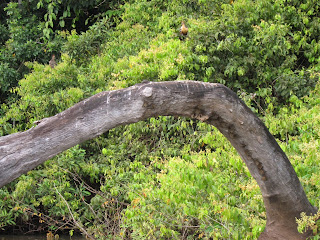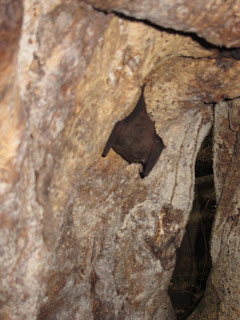We start with an early hike through the forest.
Our first stop is at a fire ant tree. The area around the tree is clear because the ants keep the area clean. This keeps competing plants away from the tree where they have made their home.
This plant is normally found in Central America and was probably dispersed this far south via bird.
It has a flower which blooms once every 5 years for only two days. We didn't see any blooms, though you might be able to imagine the flower. It is in the same family as the bird of paradise.
It also has huge leaves.
This is the bark of the cinchona tree, which contains the cure for malaria. It taste a little bitter.
On our hike we see a few palm trees.
The erotic palm:
The pregnant palm's bulge in the trunk is a place for storing water.
The pregnant palm:
The walking palm grows new roots and old roots die off. It is believed that as this tree grows new roots, and old roots die, it adjusts its location to get closer to nutrients or to the sun. However, the information on how much this tree moves or whether it even does at all is debated.
The walking palm's roots have spikes on them, which also makes sitting inside them a good time out spot for naughty children.
The walking palm:
We see birds and butterflies along the path.
This butterfly is hiding:
As part of our hike, we cross a lake in a canoe.
Near the lake are hoatzin, or "stinky birds.". Young hoatzin have claws on their wings that allow them to climb trees, and can swim underwater. Once they are older and can fly, they lose their claws. And yes, the birds stink.
Here is another stinky bird. There are also bats along the underside of the log.
We make our way to the dock on the other side.
At the dock on the other side, we are greeted by a spider. It's a friendly spider.
After we get on land, we look at a strangler fig. This is a vine is a tree parasite. Its seed is dispersed by a bug that flies over and drops the seed onto a high branch. From here, the strangler fig gradually takes over and kills the tree. This particular one has completely killed the tree that was once here. A hollow spot remains where the tree once stood. This hollow area is large enough for all four of us to climb inside.
The vine looks like a tree itself.
We climb in.
And look up...
We find a friend inside. He is having ...dinner? He is eating a butterfly.
We climb back out.
After the strangler fig, we come to a large kapok tree. This is considered to be a "tree of life."
On the way back, we spot a bright dragonfly.
And again on the lake, we decide to feed some piranhas.
These are vegetarian piranhas; we give them bread. They are very fast and only ever seen for a split second. Most of the fish actually coming up to eat are another kind of fish. The piranhas are bigger. You might see their orange color.
Back on the other side of the lake, we try a sample something one might eat in order to survive in the jungle: termites. I don't really taste anything--it is so small. Supposedly the head is the best part.
We then find some bullet ants. I guess they have a similar taste in jungle foods. This one is carrying a termite. These ants are named bullet ants because the pain of their bite is said to be equal to being shot with a bullet. According to our guide, the neurotoxin in their bite is 2% the strength of that in a cobra bite. Though often solitary, bullet ants will organize hunting parties to take on a foe. With their venom, they can paralyze and take down quite a large victim.
Bullet ant home:
Blue morph butterfly:
This one is an older butterfly. They normally are much more mobile and difficult to capture on photo.
We also stop at a rubber tree on the way back. The sap turns rubbery when dried.
I walk around back at the lodge.
Later, we go to a local farm.
These were called "monkey balls." They are called this because when you eat one, it is so spicy, it makes you jump around like a monkey.
We got to wash the monkey balls down with some sweet sugarcane.
After the farm tour, my brother and our tour guide go swimming in the river.





















































